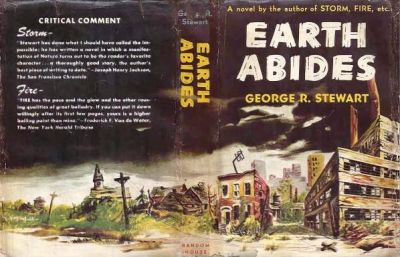Purple Mountain Majesties
Earth Abides
By George R. Stewart

30 Jun, 2024
George R. Stewart’s 1949 International-Fantasy-Award-winning Earth Abides is a stand-alone post-apocalyptic novel.
Bitten by a rattlesnake while alone in the mountains, Isherwood “Ish” Williams has no choice but to convalesce in isolation. The rattlesnake bite does not kill Ish. In fact, it saves his life.
While Ish was laid up in his cabin, the world he knew ended.
A new, extremely virulent, extremely deadly measles virus1 appeared. Airplane travel allowed the pandemic to reach all corners of the world. People died in the hundreds of millions. Governments collapsed. In short order, so did civilization.
By the time Ish makes his way back to his native Berkley, the world is a very empty place. Some towns are completely bereft of humans, the occupants having tried to flee the plague. Others are filled with rotting corpses.
Survival is not a pressing issue. The power will remain on for months. Water will still come from taps. Stores no long have customers but they have abundant supplies. As long as Ish is prudent and lucky, he could survive for a very long time.
Ish is luckier than he is prudent. Setting out to survey the state of the former USA, he encounters few survivors. None are people with whom the loner wishes to spend time. Many will not survive the coming winter. In the end Ish returns to Berkeley2.
On a whim, Ish adopts a poorly behaved but adorable dog, Princess. Because of Princess, Ish meets Emma. The couple becomes the seed of a new, although very small community of survivors in Berkley: Ish, Em, Ezra, Ezra’s wives Molly and Jean, Ralph, Evie, George and Maurine. Babies soon follow.
The Tribe could embrace a simple life of hunting, gathering, and salvaging what they need from the slowly decaying remnants of civilization. Alternatively, they could follow Ish’s plan and rebuild civilization. There are just two problems with Ish’s grand vision: nobody but him sees the need, and Ish lacks the necessary leadership skills to sway them.
Ish might have been the father of a new civilization. Instead, he will become a god.
~oOo~
Ish’s name may be a reference to Ishi, last of the Yahi3. Ish and Ishi live out mirror lives. His people annihilated by genocide, disease, and mishap, Ishi reluctantly was forced to assimilate into American society and become a sort of museum exhibit in 1911. American Ish is forced to become a hunter-gather of sorts. The two men have this in common: they are the last survivors of their kind, and their old way of life is never coming back.
Steward provides two parallel narratives: one follows Ish, while the other provides a god’s‑eye view of the changes in North America following the sudden obliteration of most humans. There are dramatic changes as the world adjusts, few of which benefit of the pre-plague crops, food animals, or pets. If this book had been written been for kids, it would have won a Newbery.
Ish is an open-minded liberal by the standards of the 1940s, which means he doesn’t mind that Em is by 1940s standards African American. It also means he’s genially contemptuous of everyone outside his race, class, and gender, whether it’s black sharecroppers who have (unlike Ish) preserved agriculture or his fellow Tribe members. He also off-handedly embraces eugenics, at least where traumatized Evie is concerned. For this reason, he underutilizes what could have been valuable assets.
While Ish’s poor choices are a wonderful plot facilitator, they might stem from the author’s effort to explore founder effect on societies, the social analog of insular biogeography. Chance determined which survivors would form the Tribe; that’s why the Tribe turns out as it does. Other groups, with a different assortment of personalities, preserved different skills but lost knowledge the Tribe had preserved. These groups are very different from the Tribe.
While one can classify this novel as a science fiction and/or post-apocalyptic novel, it might be more useful to see Earth Abides as another one of Stewart’s ecological explorations. He also wrote the 1936 Ordeal by Hunger (which covers the Donner Party), the 1948 Fire (which covers a vast forest fire), and 1941’s Storm (which covers a storm). It should be no surprise that the novel lacks many of the standard features of post-apocalyptic fiction. In particular, there is very little deliberate violence. It’s not a thriller, but it’s a fascinating narrative that well deserved its International Fantasy Award. No surprise that Earth Abides is still in print.
Earth Abides is available here (Amazon US), here (Amazon Canada), here (Amazon UK), here (Apple Books), here (Barnes & Noble), here (Chapters-Indigo), and here (Words Worth Books).
1: Stewart chose his plague perhaps better than he knew. I do not believe it was known in 1949, but measles resets immune systems. Ish believes that there was a wave of secondary deaths as people perished from events from which civilization would have saved them, This may have included secondary epidemics, as people who survived the measles then died of other diseases.
2: Until I looked up Berkeley to check the spelling, which I invariably get wrong, I did not know it was named for that Bishop Berkeley.
3: As you know, Ishi’s life was documented by Theodora Kroeber, whose daughter Ursula Kroeber Le Guin enjoyed some success as a writer.
